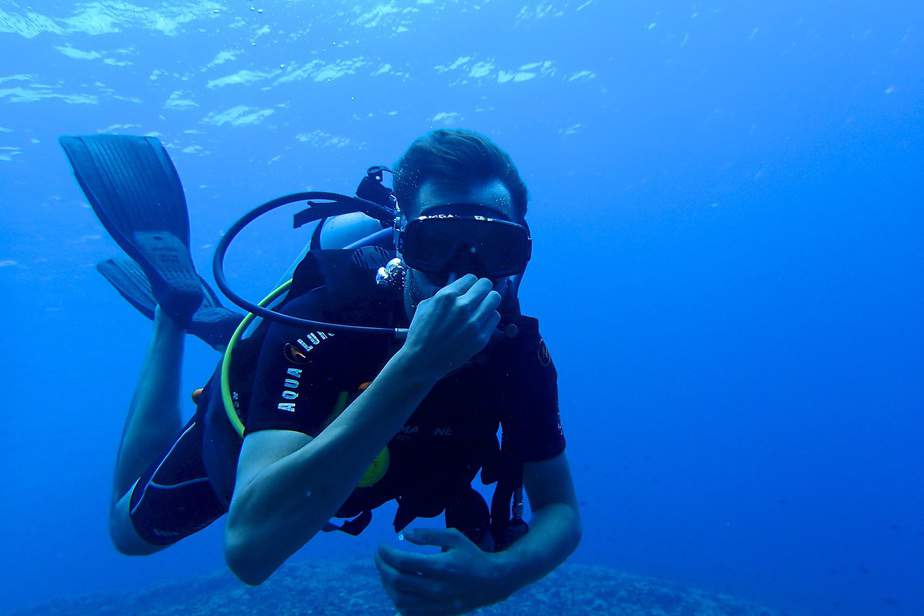The most popular type of BCD is the jacket style. It is probably what most beginners were taught to dive with and they just stuck with it. Due to their popularity, jacket BCDs are what you see the most in dive shops. However, many divers don’t know about another great option: the back-inflate style BCD which is great for tech diving. Both types of buoyancy compensators have their advantages and disadvantages. So which one should you get: the back inflate BCD vs. jacket style?
What is a Vest or Jacket Style BCD?
Jacket style BCDs are popular because their design is intuitive and very familiar to a lot of divers. They are incredibly easy to don and doff because they are reminiscent of a life jacket. At least by the surface, jacket style BCDs certainly perform a similar function by keeping your head and shoulders above the water. On top of that, the jacket style is what is traditionally used in open water courses, so it is what most people are most exposed to.
What is a Back-Inflate BCD?
Back-inflate BCDs are lesser known because they used to be exclusively used by technical divers. As the name suggests, the air cell is located at the rear of the BCD. Because of this, they are sometimes referred to as a diver’s “wings.” The position of the bladder frees up the diver’s torso so they have more range of motion when diving. You can learn more about back-inflate BCDs by reading this article.
Additionally, there is a type of back-inflate BCD known as the backplate and wing (BPW) style. It is unique because it is completely modular. The BPW style allows for infinite possibilities when it comes to mixing and matching parts. You can swap from a tropical warm water setup to a cold water setup by swapping in a larger wing.
The BPW style sometimes alienates beginners due to the sheer number of parts available, but the adjustability makes it attractive for technical diving. If you want to learn more about BPW BCDs, we have written extensively about them in this article.
Back Inflate vs. Jacket BCDs: A Comparison
At the Surface
Jacket style BCDs will hold divers in a vertical position at the surface, keeping their head and shoulders above the water much like a life jacket would. When fully-inflated, jacket style BCDs can feel uncomfortable since the air cells are located around the torso.
Back inflation style BCDs hold divers in a horizontal position meaning at the surface it will be constantly rolling a diver face down into the water. This can seem frustrating for divers who are used to jacket style BCDs. It can also be an issue if a diver has to wait at the surface for a long time for the boat to pick them up.
This issue can be resolved by leaning back so that the air bladder is below you, now working to keep your entire body afloat. Furthermore, the tendency to put the diver into a horizontal position becomes an advantage underwater, where maintaining trim is beneficial for smooth diving. When fully inflated, back-inflate BCDs feel more comfortable since the rear bladder does not squeeze a diver’s torso.
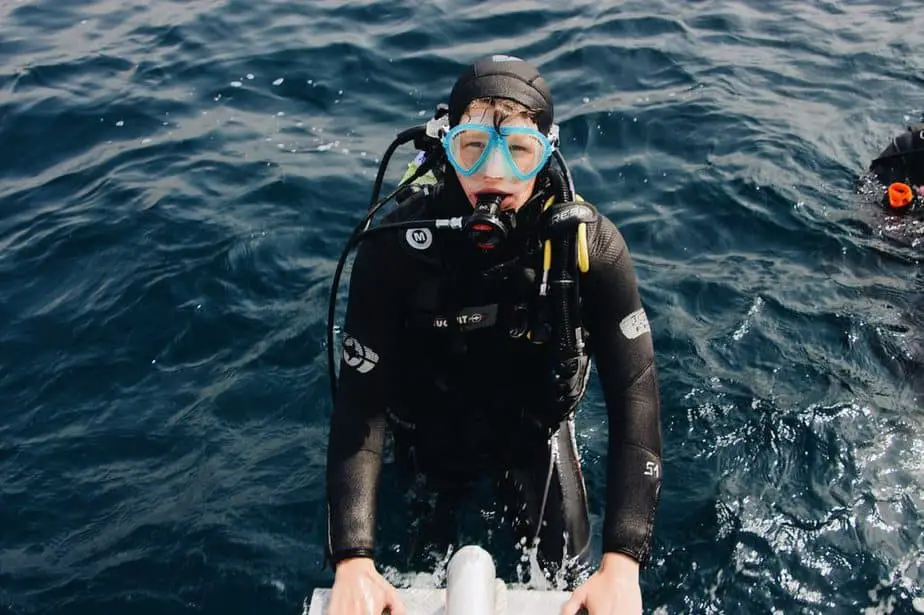
Underwater Performance
Since divers spend most of their time underwater, they tend to prefer back inflation BCDs which naturally hold them in the ideal horizontal position which reduces drag. This makes it easier to navigate through the water and can decrease the air consumption rate for longer bottom times. Additionally, since back-inflate BCDs don’t constrict the torso, many divers find them much more comfortable and easier to swim around in.
On the other hand, as we mentioned above, jacket style BCDs force the diver into a vertical, fins down position. This is less efficient since divers need to spend energy to maintain the horizontal position.
To address this issue, manufacturers have included weight pockets, otherwise known as trim pockets, typically located at the middle back or rear shoulders. Divers can put lead weights into these pockets to adjust their position so that they can maintain horizontal trim without wasting energy.
Ease of Deflation
For the most part, it is easier to dump the air in a jacket style BCD compared to the back-inflate style. Since the air bladder is pressed tightly against the diver’s chest, shoulders, and waist by the straps, it helps to force air out more quickly when deflating.
Conversely, back-inflation models have the bladder, or wing, hanging freely behind them. When deflating, this means nothing is squeezing against it to force the air out more quickly. Not only is it slower, but sometimes air can get trapped under folds or crevices that form as the wing deflates.
To address this, some manufacturers have started wrapping bungees or elastic bands around the air cells, which provide extra force when squeezing air out and putting the deflation speed closer to a jacket style.
Adaptability
One area where the back-inflate BCD has a clear advantage over a jacket-style BCD is in its adaptability. Specifically, the backplate and wing type is entirely modular, and you can swap out the air cell, harness, backplate, or anything else you want to suit your diving needs. The ability to switch out the air cell is so incredibly versatile that a BPW can be adapted to any type of diving.
For instance, if a diver needs less lift they can switch to a smaller wing. Conversely, if a diver wants more lift, or intends on diving using a twin-cylinder setup, he can swap the wing out for one that can meet both of his requirements. Instead of purchasing multiple BCDs for each type of diving, you can have just one BCD and swap components as needed. It is much cheaper and more convenient to do so.
In a similar vein, if a component gets damaged, you can easily remove and replace it for a new part instead of buying a new BCD. You can also upgrade parts at your leisure. Jacket style BCDs are less versatile in this regard.

Additional BCD Buying Considerations
Diving Style
This is more of a general consideration, but when shopping for a BCD, you should consider how deep you plan on diving. If you plan on diving in cold water and/or plan on diving deep, then you will need a BCD with a high lift capacity. Generally, the deepest and most technical dives are done with a backplate and wing back-inflate BCD.
If you are a beginner, you may need to consult with a more experienced diver about what kinds of dives you will be going on and how deep you will go. Once you know, then you can figure out which BCDs meet those requirements, be it a jacket or back-inflate BCD. If you won’t be diving very deep, then a jacket style BCD is suitable. We have also written a comprehensive guide on the best beginner BCDs which you can read here.
For those planning on diving deep, once again, a backplate and wing BCD is ideal. You can swap the components around so that it is suitable for both tropical warm water diving or cold water deep diving.
Experience Level
If you are a beginner, or are introducing someone to diving, then you should consider the jacket style BCD due to its intuitive design and ease of use. Jacket style BCDs let divers float vertically at the surface so that their head and shoulders are above the water. Back-inflate BCDs, on the other hand, will be pushing the face toward the water; not a good “feature” for a nervous diver.
Once one has more dives under their belt and has the basics down, then it is time to explore the various BCD cells. This is when a backplate and wing BCD is ideal. Now that you know what you want out of a BCD, the customizability of this modular style becomes an advantage and not a hindrance. You can play around with swapping the air cell or harness to get the perfect fit and superior performance underwater.
Testing Out a BCD
Nowadays, you can purchase anything online, even BCDs. When it comes to buying anything you will be wearing, it is best to first try it on before making a decision. If there is a local dive shop nearby, you could pay them a visit and ask if you can try some on. Many dive retailers allow prospective buyers to demo the BCD in a pool. If not, then perhaps you can rent one.
Try out the various types of BCDs: not only the jacket and back-inflation style, but also the backplate and wing or even the hybrid style if they have them. Test out how well they fit your body shape. Practice all the various movements you will be performing: ascending, descending, swimming, floating by the surface. Most BCDs are high-quality and have similar functions and features, but the goal is to find one that fits your body perfectly.
Buying vs. Renting
Depending on how often you dive, you may need to decide between renting or buying a BCD. When renting, you are leaving many variables up to chance. Sometimes what they have to offer just doesn’t meet your requirements. They may have incompatible sizing, uncomfortable padding, too low of a lift capacity, and so on. Getting a BCD that fits you perfectly is like winning the lottery.
Dive shops and hotels will assuredly have jacket-style BCDs available but a back-inflate style, particularly a backplate and wing, might not be available. Prior to making reservations, we recommend asking what kind of equipment the hotel or nearby dive shops have to offer.
If you dive only on holidays, renting may be the better option purely from a financial perspective. If you dive frequently or want to ensure the BCD fits you comfortably each time, then you will need to purchase your own.
There is also the issue of maintenance. When renting, you don’t know how many people have worn the BCD. They could have used it improperly, or staff may not have properly maintained it. If you want peace of mind, with your own BCD, you know that it has been properly maintained and sanitized.
Next, consider how many locations you will be visiting and whether bringing your own BCD is convenient or not. Renting in this case may save you from having to lug around a bulky, cumbersome BCD. Thankfully, there are lightweight BCDs designed specifically for travel and there are both jacket and back-inflate options available.
We recommend women purchase a BCD specifically designed for women. When renting, you may be given a unisex model which is geared more towards men than women. Spare yourself the headache and dedicate some time right now to finding a good BCD that fits you so that you can fully enjoy your vacation. If you need help selecting a BCD for women, then you can read this review to get started.
Popular Jacket BCDs
Now that you know a bit about what to look for in a BCD, you may want to take the plunge and buy one. In the next couple of sections, we review a few of the most popular jacket and back-inflate style BCDs to give you an idea of the kinds of BCDs you should be looking for.
Cressi Start
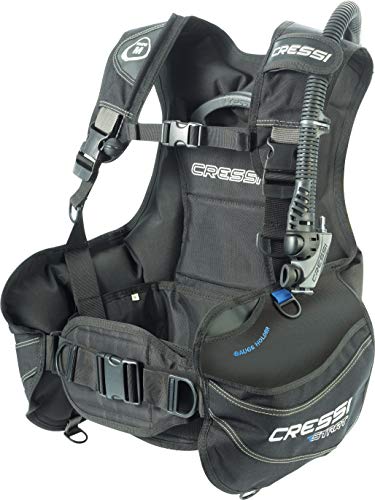
- Dry Weight: 5.73 lbs (2.6 kg)
- Lift Capacity: 29.3 – 45 lbs (13.3 – 20.4 kg)
- Weight Integrated: No
We’re going to start off with a cheap but reliable BCD as our first recommendation. This is the most affordable BCD you will find anywhere. The price of the average BCD is double or triple the cost of the Cressi Start. Despite being so affordable, Cressi have somehow made a BCD that is durable, comfortable, and most importantly, safe for recreational diving at an unbelievable price point.
In case you are not aware, Cressi is perhaps the most trusted name in the underwater sporting gear market. Cressi has been in business since the 40s and they have only gotten better with time. Since the Start is a jacket-style BCD, beginners will find that it is easy to don and doff.
In addition, the Start is designed to be beginner-friendly. Its sternum and torso straps are fully adjustable which will help you get the perfect fit. The Start is also fitted with a squeeze-style quick release so that you can quickly remove it any time you want.
Furthermore, the Start’s waist strap and cummerbund are independently suspended from the air bladder which keeps it floating away from the diver, meaning it will alleviate the squeezing effect commonly found in other jacket BCDs when inflated to full capacity. On top of it all, you get rigid back support and full padding to keep you comfortable while on a dive.
The cherry on top is the fact that the Cressi Start is incredibly lightweight and compact. You could easily bring it with you while traveling, and it won’t be much of a burden on you the way other non-travel BCDs would. There is a lot to like about the Cressi Start, which is why we are wholeheartedly recommending it to beginners and travelers on a budget.
AquaLung HD Pro
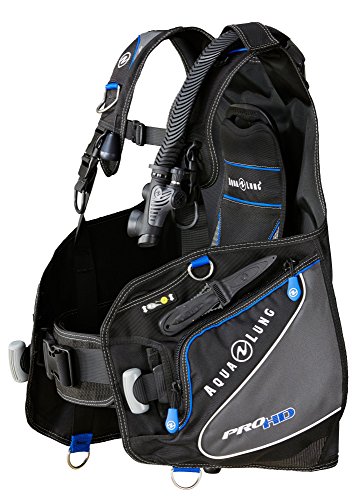
- Dry Weight: 10 lbs (4.5 kg)
- Lift Capacity: 24 – 55 lbs (10.9 – 25 kg)
- Weight Integrated: Yes
If you’ve rented a BCD in the past, then you’ve probably already encountered the Aqualung HD Pro, a favorite of dive shops around the world. The reason is because the HD Pro is a simple BCD that comes with many useful features that divers of all experience levels can appreciate.
To start, this device uses an integrated weight system with quick-release functionality to quickly unload all of the lead weights in the event of an emergency. The HD Pro has a hard molded handle so that you can easily carry it around.
If you like to bring along lots of scuba accessories, there is plenty of space on the HD Pro to attach it to. It has numerous metal D-rings located by the hips, waist, and on the shoulders for you to clip accessories onto and access them. The HD Pro has a knife mounting grommets on the left side for your trusty dive knife.
Furthermore, the clips on the shoulders lets the HD Pro be very easily donned and doffed. Storage space also won’t be an issue with its double-zip storage pocket which can be opened from either side. All of these features keep the device’s dive profile low so that you can dive with minimal drag. The Aqualung HD Pro is another great jacket BCD to invest in.
Popular Back-Inflate BCDs
Moving on, in this section we will go over a couple of the most popular and well-reviewed back-inflate BCDs.
Scubapro Hydros Pro
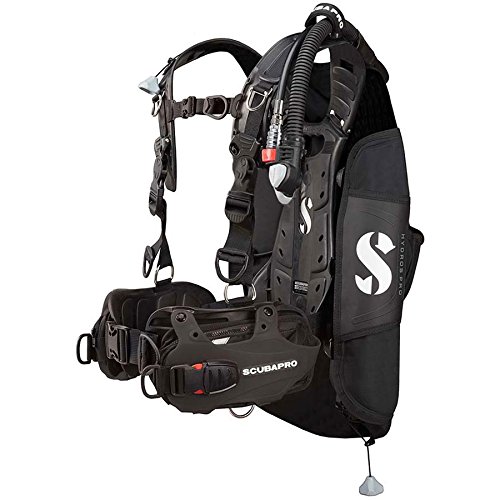
- Dry Weight: 8-9 lbs (3.6 – 4.1 kg)
- Lift Capacity: 36- 40 lbs (16.3 – 18.1 kg)
- Weight Integrated: No
The Scubapro Hydros Pro is a backplate and wing style back-inflate BCD, meaning it is fully modular so that you can customize it however you want. It also means that it is versatile and can be used for any type of diving.
If any component is damaged, you need to only replace that part rather than the whole thing. No more bringing your BCD to a service center; the Hydros Pro will outlast even its most durable competitors. You will save a ton of money on maintenance or repair fees compared to other non-modular buoyancy compensators.
To top it all of, each component on the Hydros Pro is very durable in their own right. For instance, the harness is made of fabric-free monoprene, which is quick-drying, UV resistant, as well as fray and tear resistant. The other parts are also made from durable materials that are resistant to chemicals, abrasions, and impacts. This all culminates in a BCD that can be put through the ringer and come out just fine.
Lastly, the modularity also means the Hydros Pro is truly unisex as long as the parts you get fit your body shape and size. The downside of the modular design is the period of trial and error as you are figuring out what works for you. They also have a very high upfront cost, but the money you save in repairs means over a long period of time its cost is not so different from other BCDs.
If you want a BCD that can last you your entire dive career, then consider the Scubapro Hydros Pro.
Mares Bolt SLS
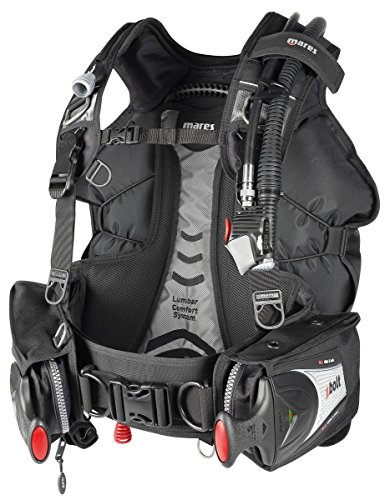
- Dry Weight: 8.58 lbs (3.9 kg)
- Lift Capacity: 46 lbs (21 kg)
- Weight Integrated: Yes
The Mares Bolt SLS is a durable BCD with plenty of storage space: zippered pockets, several attachment points, and numerous weight integrated pockets. It also has swiveling shoulder clips so that you can get a more comfortable fit and have more range of motion while swimming underwater.
Next, the integrated weight system on the Bolt SLS supports both hard and soft weights. The Bolt SLS doesn’t have any need for a bulky cummerbund system; instead it uses only a single strap to keep it secure, and the stainless steel buckle can withstand the rigors of rough diving conditions.
By having such a simplistic design, the Bolt SLS keeps clutter to an absolute minimum which frees up your freedom of movement even more. To further add to its streamlined design, it has a foldable pocket so that you can store items when you need to, and tuck it away when you don’t.
Overall, the Bolt SLS is a rugged BCD with a streamlined design, both of which are key to any good BCD. The Bolt SLS comes in numerous sizes, so you can find the perfect one for you no matter your body size.
Back-Inflate BCD vs. Jacket Style: The Verdict
In the battle between the back-inflate vs. jacket style BCDs, which is superior? In this case, there is not a clear-cut winner. One style can be better than the other depending on the various factors covered in the sections above, but the most important ones are the experience of the diver and where one plans on diving.
Generally speaking, jacket-style BCDs are better suited for beginners. People are already familiar with its design from other things like a life jacket or just a regular jacket. Thus, even a complete newbie will know how to don and doff one very quickly. They will also feel safer by the surface when the device keeps their head above the water.
Compare this to the back-inflate style BCD, which is better for intermediate to advanced divers. The rear bladder (the “wing”) of a back-inflate BCD helps divers reduce drag and maintain horizontal trim underwater. Some back-inflate BCDs are completely modular, allowing for components to be swapped out to suit every kind of diving. Rec/tec divers will be able to figure out which components they want but a complete beginner will be overwhelmed by the options.
With all of this in mind, you will be able to decide whether a jacket style or back-inflate style buoyancy compensator is for you. If you are interested in more scuba BCD reviews, we recommend you check out this one.

